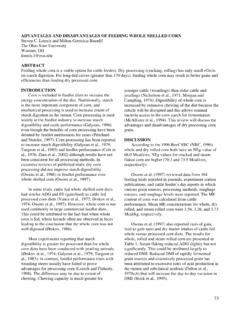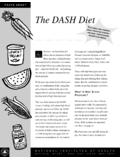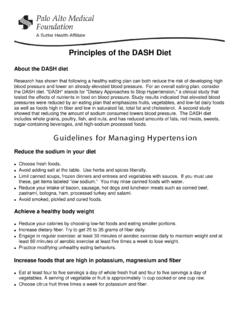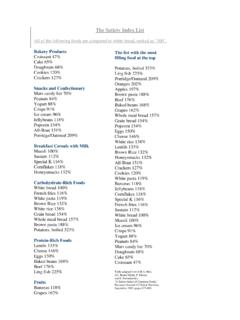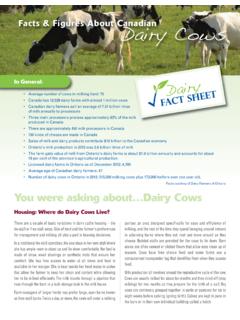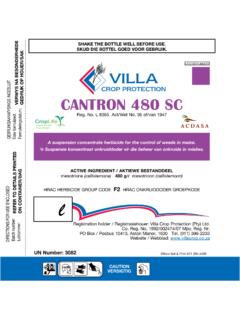Transcription of METHODS FOR MEASURING MOISTURE CONTENT OF …
1 238 METHODS FOR MEASURING MOISTURE CONTENT OF GRAINS AND IMPLICATIONS FOR RESEARCH AND INDUSTRY Fred Owens and Steve Soderlund Pioneer Hi-Bred, A DuPont Business ABSTRACT Several METHODS were used to measure weight loss on drying and MOISTURE CONTENT of 120 samples freshly harvested corn grain containing from 12 to 45% MOISTURE (10 different hybrids; 6 harvest dates; grain separated from the butt and tip section of multiple ears). MOISTURE CONTENT varied with measurement method. Compared with direct measurement of water CONTENT by a chemical reaction (the Karl Fischer method), drying whole kernel corn samples for 144 h at 62 C failed to remove approximately 3% of the water, especially from drier samples.
2 Weight loss during oven drying at 105 C for 144 h matched Karl Fischer estimates of MOISTURE CONTENT very closely. Rapid MOISTURE measurements by near infrared procedures were almost as accurate as 105 C drying. Capacitance-conductance measurements were slightly less accurate than 105 C estimates, particularly for samples that contained more MOISTURE . Compared with MOISTURE CONTENT of kernels obtained from the tip half of the ear, kernels from the butt half of the ear contained up to 5% more MOISTURE . Compared with the samples tested, weight loss on drying would be greater from samples that contain volatile compounds derived from microbial fermentation (high MOISTURE corn ; silage; wet distillers grains).
3 For such samples, more accurate prediction of caloric value would be obtained by MEASURING volatiles and water CONTENT separately by appropriate procedures. If properly calibrated, near infrared techniques hold promise for obtaining such measurements. INTRODUCTION MOISTURE CONTENT of a feed usually is calculated as the weight lost by material during application of heat to a sample. Indeed, Thiex and Richardson (2003) proposed that the term weight loss on drying should be substituted for the term MOISTURE when discussing feeds. Hence, the term dry matter probably should be replaced with 100 minus weight loss on drying.
4 This revised terminology is based primarily on the observation that numerous compounds (organic acids, ethanol, ammonia) in addition to water become volatile and are lost when a feed is heated. But in addition, heating can result in chemical reactions that release water. Of primary concern in the grain trade is the loss of volatile compounds during drying of certain feedstuffs, , silages, high MOISTURE corn , wet distillers products. Loss of volatiles results in an underestimate of dry matter CONTENT of the feedstuff; in turn, this inflates the efficiency of feed use (gain to fed dry matter ratio) as an estimate of the true energetic efficiency of fermented crops and wet distillers products.
5 If weight lost during fermentation is combined with the improved gain to feed dry matter ratio, these two errors will partially cancel, but very seldom are these two measurements both measured and combined. Consequently, if one inhibits fermentation so that a fermented product contains a lower concentration of volatile compounds, dry matter recovery increases. Further, apparent digestibility increases because the dry matter fed has fewer volatile compounds that are lost during drying. Perkins (1943) noted that 4 to 7% more dry matter was lost from corn silage by 100 C drying than by toluene distillation.
6 Fox and Fenderson (1978) found that try DM of corn silage was underestimated by 8% and 11% by oven drying at 60 and 100 C, respectively. As discussed by Thiex and Richardson (2003), chemical water CONTENT should be measured by the Karl Fischer titration method. By this procedure, the extent of a chemical reaction quantifies the amount of water present. Being considerably more complex, time-consuming, and expensive than drying samples with a forced air, vacuum, or microwave oven, the Karl Fischer titration seldom is used for routine measurement of MOISTURE CONTENT . However, even the standard operating procedures for MOISTURE measurement by oven drying will vary with feed type and among laboratories.
7 Standard procedures include vacuum oven drying at 95 to 100 C (AOAC ), forced air oven drying at 103-104 C for 5 h (AOAC ), drying at 135 C for 2 h (AOAC ), and 105 C for 3 h (NFTA ). Drying samples above 65 C without aeration for rapid removal of MOISTURE will cause formation of Maillard products that will be assayed erroneously as lignin (Van Soest, 1982). As a result, some laboratories use a two-stage procedure; to 239 obtain a sample for chemical analysis, the sample is first dried at a lower temperature. A sub-sample then is dried further drive off any remaining MOISTURE . Assay results are converted to a dry matter basis based on the additional weight lost during drying at the higher temperature.
8 Some laboratories substitute near infrared reflectance or transmission (NIR/T) procedures for the high temperature drying. METHODS for determining the nutrient CONTENT of dried distillers products were compared recently. Drying at 135 C overestimated the MOISTURE CONTENT of distillers products determined by the Karl Fischer procedure, so a lower drying temperature (105 C for 3 h) currently is recommended (AFIA, 2007). Whether the additional weight lost at the higher temperature is due to loss of additional volatile compounds present in the product or to formation of complexes ( , Maillard products) that result from rearrangement of sugars that dehydrate when condensing with amines is not certain.
9 One additional procedure that was popular in the past for silage, toluene extraction, is an awkward and inefficient process and may extract some volatiles, as well. However, the toluene distillation procedure proved more accurate than freeze drying or oven drying at 70C or 100C for high MOISTURE roughages and feces in one report (Aerts et al., 1974). Because of its speed, microwave oven drying is a preferred sample drying method at many analytical laboratories. Uneven microwave heating can cause charring of samples that interferes with subsequent spectral measurements and perhaps with wet chemistry assays, as well.
10 Indirect measurements that do not involve removal of water also are used to quantify the amount of water present in a sample. Approved as an official method for determining the MOISTURE CONTENT of grain, electrical conductivity tests are used widely to determine the MOISTURE CONTENT of unfermented grain, but for fermented grains or feeds and for feeds with acids added ( , propionic acid as a preservative), electrical conductivity is increased by the acids leading to an overestimate of MOISTURE CONTENT . Thus, harvested grains should not be allowed to ferment prior to electrical conductivity measurements.

